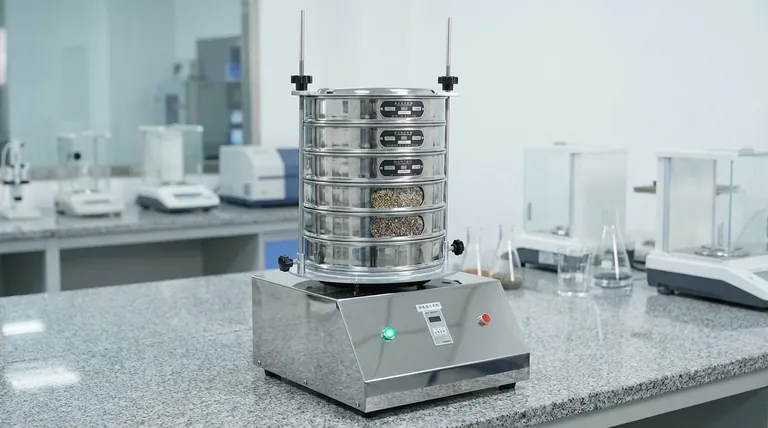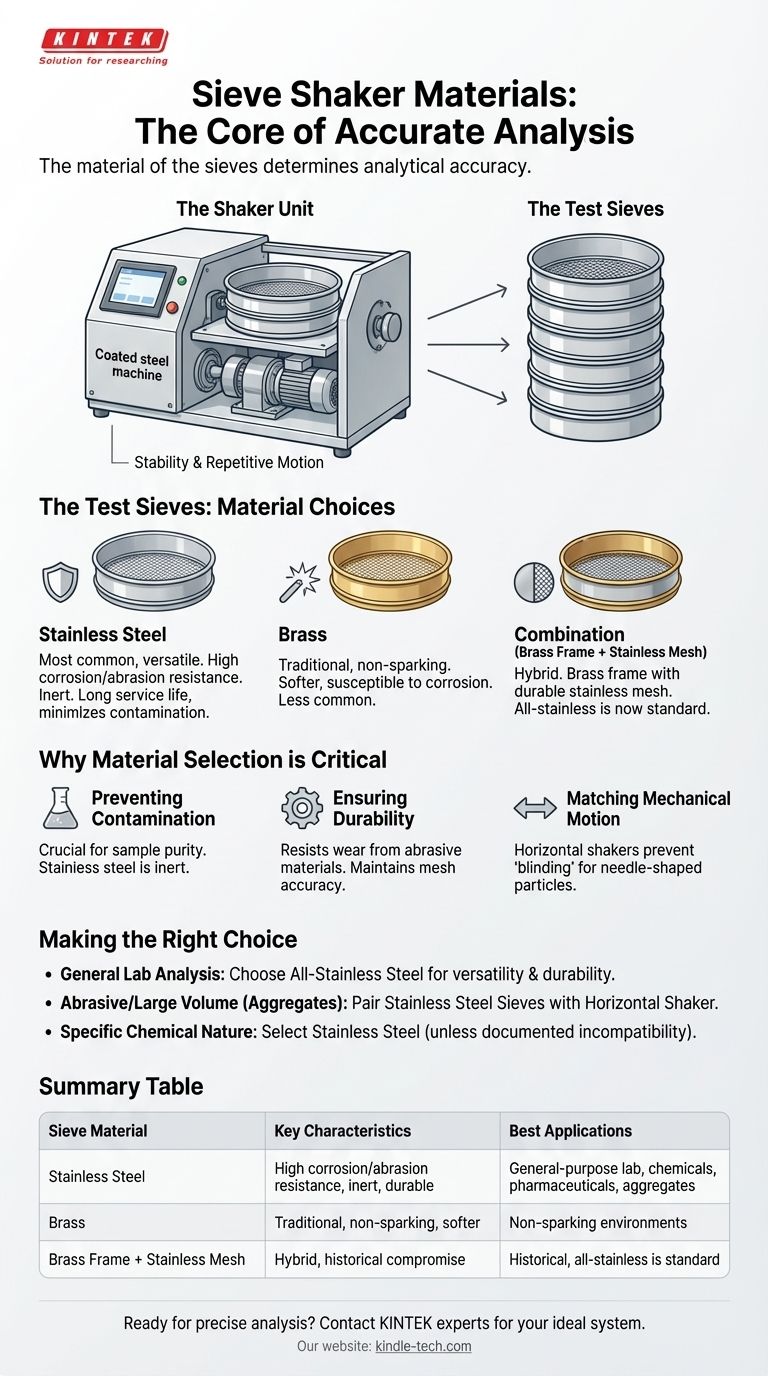To be precise, the core components of a particle analysis system—the test sieves—are typically constructed from stainless steel, brass, or a combination of a brass frame with stainless steel mesh. The shaker unit that agitates these sieves is built from durable materials designed for stability and longevity, but the material of the sieves themselves is the critical factor for analytical accuracy.
The choice of material for your test sieves is not a minor detail; it is a critical decision that directly impacts the accuracy of your particle analysis, the longevity of your equipment, and the prevention of sample contamination.

Deconstructing the Sieve and Shaker
A "sieve shaker" is a system with two distinct parts: the mechanical shaker unit and the interchangeable test sieves. Understanding the materials of each is key.
The Shaker Unit
The shaker machine itself is designed for stability and repetitive motion. Its body is typically made of coated or painted steel to provide weight and durability, housing the motor and control systems. Modern units often feature advanced components like touchscreen controls for precise and repeatable analysis.
The Test Sieves
The sieves are the calibrated instruments that perform the actual particle separation. The material choice here is paramount.
Stainless Steel
This is the most common and versatile material. Its high resistance to corrosion and abrasion makes it suitable for the vast majority of materials, from fine powders to aggregates. It ensures a long service life and minimizes the risk of contaminating the sample.
Brass
Brass sieves are a traditional option. While less common now due to the durability of stainless steel, they can be specified in environments where non-sparking properties are a consideration. However, brass is softer and more susceptible to corrosion from certain chemicals.
Combination (Brass Frame, Stainless Steel Mesh)
This hybrid option pairs a brass frame with the more durable and precise stainless steel woven-wire mesh. This was often seen as a compromise, but all-stainless steel construction is now the predominant industry standard for its superior performance.
Why Material Selection is Critical
Choosing the right sieve material is a function of your specific application. The wrong choice can compromise your results.
Preventing Sample Contamination
The most important factor is ensuring the sieve material does not react with or abrade into your sample. Stainless steel is largely inert, making it a safe choice for most chemical and pharmaceutical applications.
Ensuring Durability and Longevity
Sieving can be an abrasive process, especially with materials like construction aggregates. Stainless steel offers superior resistance to wear, ensuring the precisely calibrated openings in the mesh remain accurate over time.
Matching the Mechanical Motion
The reference to horizontal sieve shakers highlights a crucial point. These machines are preferred for needle-shaped, fibrous, or elongated particles. The horizontal circular motion keeps these particles from blocking the mesh, a phenomenon known as "blinding," which is why this shaker type is ideal for aggregates and other construction materials.
Making the Right Choice for Your Goal
Your application dictates the ideal combination of sieve material and shaker type.
- If your primary focus is general-purpose lab analysis: Choose all-stainless steel sieves for their versatility, durability, and resistance to contamination.
- If your primary focus is analyzing abrasive or large-volume materials (e.g., aggregates): Pair durable stainless steel sieves with a robust horizontal shaker to prevent mesh blinding and ensure efficient separation.
- If your primary focus is working with materials of a specific chemical nature: Always select stainless steel unless a documented chemical incompatibility requires an alternative material.
Ultimately, selecting the correct material is fundamental to achieving reliable and repeatable particle size analysis.
Summary Table:
| Sieve Material | Key Characteristics | Best Applications |
|---|---|---|
| Stainless Steel | High corrosion/abrasion resistance, inert, durable | General-purpose lab analysis, chemicals, pharmaceuticals, aggregates |
| Brass | Traditional, non-sparking, softer | Non-sparking environments (less common due to corrosion risk) |
| Brass Frame + Stainless Mesh | Combines brass frame with stainless mesh | Historical hybrid; all-stainless is now the industry standard |
Ready to achieve precise and reliable particle analysis? The right sieve shaker materials are critical for preventing contamination, ensuring durability, and maintaining analytical accuracy. KINTEK specializes in high-quality lab equipment and consumables, including durable stainless steel test sieves and robust shaker units tailored to your specific needs—whether for general lab use, abrasive aggregates, or sensitive chemical samples. Contact our experts today to select the ideal sieve shaker system for your laboratory!
Visual Guide

Related Products
- Laboratory Test Sieves and Sieving Machines
- Laboratory Vibratory Sieve Shaker Machine Slap Vibrating Sieve
- Laboratory Sterilizer Lab Autoclave Vertical Pressure Steam Sterilizer for Liquid Crystal Display Automatic Type
- Laboratory Sterilizer Lab Autoclave Pulse Vacuum Lifting Sterilizer
- Benchtop Laboratory Vacuum Freeze Dryer
People Also Ask
- What type of materials can be separated using the method of sieving? A Guide to Efficient Particle Size Separation
- What are the standard test sieves for ASTM? Ensure Accuracy with ASTM E11 Compliant Sieves
- How do you use a sieve shaker? Master Particle Size Analysis for Quality Control
- What are advantages and disadvantages of sieving method? A Guide to Reliable & Cost-Effective Particle Sizing
- What range of particle size does the sieve analysis apply? Master the 25 Micron to 1 mm Standard



















